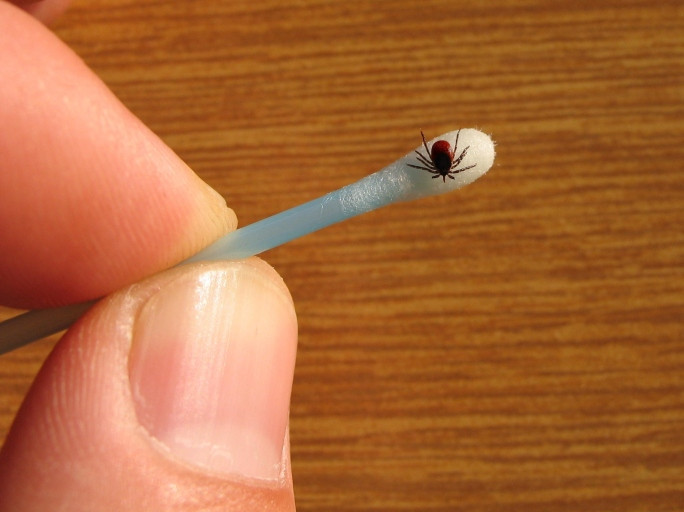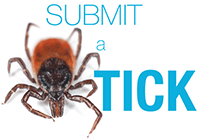Overview

Ticks are small spider-like animals (arachnids) that bite to fasten themselves onto the skin and feed on blood.
Ticks are most active during the spring, summer and fall seasons and can be active when the temperatures are above 4 degrees Celsius.
In addition to ticks that live in Alberta year-round, migrating birds bring ticks from warmer areas into Alberta during the spring.
Alberta is home to many species of ticks. Most tick species in Alberta do not carry Borrelia (B.) burgdorferi, the bacteria that can cause Lyme disease in people. However, there is evidence that tick species capable of carrying the bacteria are expanding their range in Canada.
Visit Health Canada for more information on risk areas for Lyme disease in Canada.
Protect yourself from ticks
While most ticks do not cause serious health problems, it is important to protect yourself, your family and even your pets from tick bites. Removing a tick within 24 hours of a tick bite can greatly reduce your chance of getting Lyme disease or other tick-borne diseases.
Learn how to avoid and remove ticks
When to seek medical attention
If you have been bitten by a tick and are worried about your health contact Health Link at 811. They can refer you to a resource that is appropriate to your situation.
Consult your health care provider right away if you develop symptoms following a tick bite.
If you have a rash, fever or flu-like symptoms within 30 days of a known tick exposure, talk to your health-care provider about when and where you may have been exposed to a tick.
Your health-care provider does not need the tick in order to make a diagnosis. However, if the tick is available, your health care provider may submit it for testing.
Tick-borne diseases
Lyme disease
The risk of getting Lyme disease from a tick bite in Alberta is considered very low. Between 1991 and 2022, there were 164 human cases of Lyme disease reported to the Ministry of Health. All reported cases were acquired while travelling outside of the province, in areas where ticks that carry the Lyme disease are known to circulate.
Lyme disease can affect humans, wildlife and domestic animals. It can cause an infection and, if left untreated, can cause serious, long-term complications and disability.
People may develop symptoms between 3 to 30 days after a tick bite. Symptoms of early Lyme disease infection include:
- a round, red rash that spreads at the site of a tick bite, known as a 'bull’s eye rash'
- flu-like symptoms: tiredness, headaches, sore muscles and joints and fever
Lyme disease is treated with antibiotics. Treatment in the early stage of the disease increases the chance of successful recovery.
Lyme disease diagnosis and laboratory testing
Lyme disease is diagnosed based on the presence of symptoms, physical examination, possible exposure to infected ticks and, if necessary, laboratory testing. If your health care provider suspects Lyme disease, you may be asked to provide a blood sample for testing.
The 2-step testing approach used in Alberta is endorsed by public health and laboratory experts from Canada, the United States, and other countries as the best laboratory method to support diagnosis of Lyme disease. These high standards help protect individuals from misleading false-positive (inaccurate) results and unnecessary treatments.
Learn more about Lyme disease
Other tick-borne diseases
Other ticks in Alberta can carry organisms that may cause diseases in humans such as:
- Rocky Mountain spotted fever (transmitted by Dermacentor andersoni and D. variabilis)
- Powassan virus (transmitted by Ixodes cookei and I. scapularis)
- tularemia (transmitted by D. variabilis)
The number of cases of these diseases reported to the Ministry of Health each year varies from zero to 3 cases and are mainly acquired locally.
Like Lyme disease, there is a low risk that other tick-borne diseases, such as anaplasmosis, babesiosis, ehrlichiosis or southern tick-associated rash-illness (STARI), may occur in Alberta.
Submit-a-Tick program

If you find a tick on a person, a pet or anywhere outside, consider submitting a photo of it to the Alberta Submit-a-Tick program via the eTick program.
Program purpose
The Submit-a-Tick program monitors the types and distribution of ticks in Alberta, and assesses the risk of acquiring the tick-borne Lyme disease within Alberta.
- This program does not test for Lyme disease or other tick-related illnesses in humans or pets.
- If you are concerned about a tick bite on you, you should consult your health care provider.
- If you are concerned about a tick bite to your pet, you should consult your veterinarian.
Submit a tick photo for identification
The Submit-a-Tick program accepts photos of ticks found on people, animals and in the environment.
Tick submissions in Alberta are first screened at eTick by submitting a photo of the tick. This can be done using their free mobile app (available from your app store) or directly online at eTick.ca. The submission details and image requirements on on their website.
- After submitting your photo, save the tick in a clean, empty, plastic container with a tight-fitting lid for at least 10 days. This is in case additional photographs are needed to complete the identification.
- Do not add any ventilation holes to the container.
- Ticks can be stored in the refrigerator or freezer.
- Photos submitted will be used to identify the tick species and you will typically get the results within 2 business days.
- If the tick is identified as a type that can transmit the bacteria that may cause Lyme disease, or cannot be identified by photo, you will be asked to submit the tick for additional testing to the Alberta Public Health Laboratory.
- If the tick is not identified as a type that can transmit the bacteria that causes Lyme disease, it can be discarded. Testing of ticks for other tick-borne diseases is not available in Alberta.
For questions about eTick photo submission process or getting tick speciation results, email [email protected].
Note: Alberta Health Services Environmental Public Health and Indigenous Services Canada First Nations and Inuit Health Branch offices do not accept tick submissions.
Laboratory testing of ticks
If you are asked by eTick to submit your tick to the Alberta Precision Laboratories (APL), complete and print the APL Tick Testing Request form. This form must accompany your tick to the lab. By submitting the tick when requested, you are helping Alberta Health monitor for ticks of public health concern in Alberta.
You can drop off the tick together with the completed APL Tick Testing Request form by mail, or in person at participating lab locations. Shipping instructions, including drop off locations and mailing address, are included on the form.
Note: Hospital labs do NOT accept tick submissions
Important
- A completed APL Tick Testing Request form must accompany ticks that are either mailed in or dropped off.
- Label each tick container with the eTick ID number, otherwise the lab will not be able to provide results.
- If submitting more than one tick, be sure to include only one tick per container. Each tick will need its own APL Tick Testing Request form and unique eTick ID number. Be sure to label each container and form with the corresponding eTick ID number.
- The lab will provide results to you by mail within 2 to 3 weeks. Ensure that your complete mailing address is included on your APL Tick Testing Request form if you wish to receive the results.
What the results mean
These results are not meant to diagnose or treat tick-borne illnesses in people or pets:
- eTick photo identification – identifies tick species
- APL testing – confirms tick species and, if applicable, the results of testing for the Lyme bacteria, B. burgdorferi
The results can be shared with your health care provider if you are concerned about a bite from the tick.
New in 2024
For questions about submitting ticks to or getting results from the lab, APL now has a single point of contact for any questions regarding ticks sent to the lab as a part of the Submit-a-Tick program.
The lab response team can be reached from 8 am to 4 pm (Monday to Friday):
Phone: 780-407-7121 (press 1)
Email: [email protected]
Get more information on laboratory identification of surveillance ticks.
Tick surveillance results
Tick surveillance reports
Tick surveillance summary reports
Tick surveillance data – interactive
2022 summary
In 2022, photos of 1,469 tick specimens were submitted to the eTick program. Of those, 192 were identified as Ixodes ticks capable of transmitting B. burgdorferi and 181 were submitted for further laboratory testing and 25 (13.8%) were positive.
These Ixodes ticks positive for B. burgdorferi were identified in the Central, Edmonton, North, and South Zones.
What the data means for people in Alberta
- The risk of acquiring Lyme disease from a tick in Alberta remains low.
- Because eTick and APL are new programs in Alberta, multiple years’ worth of data will be required to monitor for changing trends.
- Submission of ticks to APL is voluntary so the number and proportion of ticks are not a measure of prevalence in Alberta.
The risk of Lyme disease substantially increases when a local population of ticks capable of causing the disease becomes established. There is no evidence that ticks capable of carrying the Lyme disease bacteria have formed established populations in Alberta.